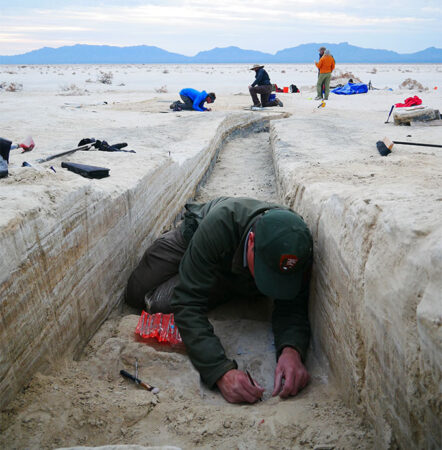This post was originally published on this site
Human footprints in White Sands National Park in New Mexico sparked controversy two years ago when scientists found the prints to be surprisingly old, dating to about 22,000 years ago. Now, two other ways of dating the fossilized tracks converge at similar ages as the first estimate, potentially resolving the dispute, researchers report in the Oct. 6 Science.
The finding adds to mounting evidence that humans arrived in North America thousands of years earlier than previously thought (SN: 7/11/18).
“The answer to how old the footprints really are is critical,” says archaeologist Loren Davis of Oregon State University in Corvallis, who wasn’t involved with the new study. “We need to be able to understand how early we should be looking for archaeological evidence in the Americas.”
In 2021, researchers described more than 60 footprints embedded in what was once mud alongside an ancient lake in what’s now New Mexico. Radiocarbon dating of an aquatic plant’s seeds in and around the footprints — which span several rock layers — suggested that people roamed there for two millennia between roughly 23,000 and 21,000 years ago (SN: 9/23/21). The result added to other evidence pushing back on a long-held theory that the first humans in North America came from Siberia via a land bridge sometime around 16,000 to 14,000 years ago.
But some scientists noted that the aquatic plants used to date the footprints could have absorbed ancient carbon in groundwater, a well-known phenomenon. “There’s a potential then for the plant to give exaggerated perspectives on its age,” says Davis, who cowrote a critique of the 2021 paper.
The criticism wasn’t surprising, says geologist Jeff Pigati of the U.S. Geological Survey’s Geosciences and Environmental Change Science Center in Denver. “We knew from the very beginning that we were going to have to independently evaluate the ages with different dating techniques.”
To add to their past work, Pigati and colleagues radiocarbon-dated pollen stuck in the same layers as some of the footprints. The pollen came from land plants, primarily pine, spruce and fir trees, avoiding the groundwater carbon issue. The researchers also collected quartz grains above the lowest footprints and used a dating method that estimates how long the quartz had been buried.
The pollen yielded an age range of roughly 23,400 to 22,600 years old, and the quartz gave an age minimum of about 21,500 years old. Both results echo the previous age estimate.
“This triumvirate is really, really robust and difficult to argue against because they’re just fundamentally different approaches for dating,” Pigati says.

Still, Davis wants the researchers to find quartz ages from more rock layers with footprints. If completed, he says, “we would very likely have a resolution.”
But the authors say many of the other layers are too thin for sampling. Collecting a sediment sample there would mix multiple layers of different silts, sands and clays, which would complicate results.
Despite possible errors in the individual dating methods, “the data overall from the [new] study strongly indicate human presence in the Americas” around 22,000 years ago, Bente Philippsen, a physicist at the Norwegian University of Science and Technology in Trondheim, wrote in a commentary in the same issue of Science.
One thing is certain: There’s still plenty to uncover about the footprints, says coauthor Kathleen Springer, a geologist also at USGS’s Geosciences and Environmental Change Science Center.
“We are learning more every time we go out there,” she says. “This paper is literally the latest chapter in the White Sands story.”
